
Sir Alexander Lindsay of Glenesk (died 1381) was a Scottish knight banneret. Active in jousting and as a crusader he was in favour with the Scottish kings David II and Robert II. [2]

Sir Alexander Lindsay of Glenesk (died 1381) was a Scottish knight banneret. Active in jousting and as a crusader he was in favour with the Scottish kings David II and Robert II. [2]
Lindsay was the second surviving son to Sir David de Lindsay of Crawford and the Byres, [3] [2] and Mary Abernethy, widow of Andre de Leschelyn (Leslie), and a daughter and co-heiress of Alexander de Abernethy. [4] Lindsay's father had been Constable of Edinburgh Castle and Berwick and active during the Wars of Independence. [4]
Lindsay was esquire to his cousin Thomas Stewart, 2nd Earl of Angus. [2] [5] Lindsay inherited his mother's lands in Angus, and also acquired some of the baronies allotted to his aunt Marget Aberhethy, Countess of Angus. [6] Upon his marriage to Catherine Stirling around 1358, he consolidated his already large maternal inheritance, with that of his wife, which would add to the extensive landholdings of the Earldom of Crawford in north-east Scotland and elsewhere. [6]
Lindsay was knighted before 1368,[ citation needed ] He was party to a truce with England as "Chevalier et Baron" in 1369. He sealed with his nephew the settlements of the Crown (1371–1373) and was Justiciary in the North possibly as early of 1371 but definitely by 1373. [2] [6]
He had many safe-conducts from the English kings Edward III and Richard II, and on December 1381, he obtained a passport to travel through England on a pilgrimage to the Holy Land. He died on Crete some time before March 1382. [2] [6]
Lindsay married Catherine Stirling (died by 1378), widow of Andrew Leslie of that Ilk and daughter to John Stirling of Glenesk. [2] [lower-alpha 1] They had children:
Lindsay married secondly to Marjorie, [2] daughter to Sir John Stewart of Ralston, and niece to Robert II of Scotland. [7] They had children:
Lindsay also had an illegitimate son Jon who was living in 1378. He also had a son James, Rector of St. Brioc, Canon and Treasurer of Aberdeen. He had dispensation for illegitimacy on taking Holy Orders, but as Sir Alexander Lindsay and his second wife must have been cousins James may have been their son. [9]
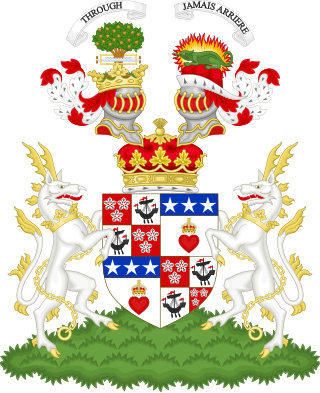
Duke of Hamilton is a title in the Peerage of Scotland, created in April 1643. It is the senior dukedom in that peerage, and as such its holder is the premier peer of Scotland, as well as being head of both the House of Hamilton and the House of Douglas. The title, the town of Hamilton in Lanarkshire, and many places around the world are named after members of the Hamilton family. The ducal family's surname, originally "Hamilton", is now "Douglas-Hamilton". Since 1711, the dukedom has been held together with the Dukedom of Brandon in the Peerage of Great Britain, and the dukes since that time have been styled Duke of Hamilton and Brandon, along with several other subsidiary titles.

Alexander Stewart, Earl of Buchan, called the Wolf of Badenoch, was a Scottish royal prince, the third son of King Robert II of Scotland by his first wife Elizabeth Mure. He was Justiciar of Scotia and held large territories in the north of Scotland.
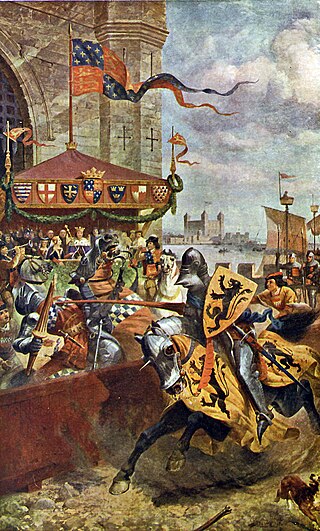
David Lindsay, 1st Earl of Crawford was a Scottish peer who was created Earl of Crawford in 1398.
Gille Críst, Earl of Angus ruled until 1206 Mormaer of Angus. He was a son of Gille Brigte of Angus and younger brother of Adam of Angus.
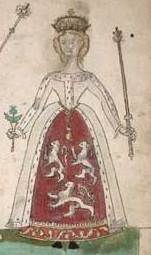
Euphemia de Ross (1329–1386), a member of Clan Ross, was Queen of Scots as the second wife of Robert II of Scotland.
Alexander Leslie, Earl of Ross was a Scottish nobleman. Born between 1367 and 1382, he was the son of Walter Leslie, Lord of Ross and Euphemia I, Countess of Ross. In around 1394, or not later than 1398, he became Earl of Ross and sometime before 1398 he married Isabel Stewart, daughter of Robert Stewart, Earl of Fife who became Robert Stewart, Duke of Albany. They had one child, Euphemia. He died at Dingwall, Scotland on 8 May 1402.
Patrick II (1185–1249), called "6th Earl of Dunbar", was a 13th-century Anglo-Scottish noble, and one of the leading figures during the reign of King Alexander II of Scotland.
Alexander Lindsay, 4th Earl of Crawford (1423–1453) was a late medieval Scottish nobleman, and a magnate of the north-east of that country.

David Stewart, Prince of Scotland, was a 14th-century Scottish magnate. He was the eldest son of the second marriage of King Robert II with Euphemia de Ross. King Robert, on 26 March 1371, the day of his coronation, created him Earl of Strathearn, and on the following day his son David performed homage to his father as of Earl of Strathearn.
Euphemia Stewart, Countess of Strathearn was a medieval Scottish noblewoman, the daughter of David Stewart, Earl Palatine of Strathearn and Caithness. She succeeded to both her father's titles after his death between 1385 and 1389, probably March 1386.
Alexander Lindsay, 2nd Earl of Crawford was a Scottish magnate. He was the son of David Lindsay, 1st Earl of Crawford and Elizabeth Stewart, daughter of King Robert II and Euphemia de Ross. He was knighted at the coronation of King James I on 21 May 1424, and subsequently was one of the hostages for King James given over to the English from 1424 until November 1427.
Alexander de Abernethy was a Scottish baron. He was a son of Hugh de Abernethy and Maria de Ergadia. Alexander was a descendant of abbots of Abernethy; his great-grandfather Laurence, great-grandson of Gillemichael, Earl of Fife, was the first to style himself Lord (dominus) His daughter Margaret married John Stewart of Bonkyll, the new Scottish earl of Angus.

John Stewart, 1st Earl of Angus, Lord of Bonkyl, jure uxorisLord of Abernethy was a medieval Scottish nobleman.
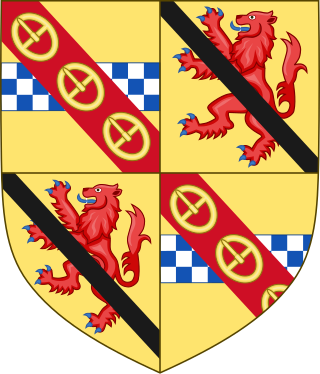
Thomas Stewart, 2nd Earl of Angus (b.b.1331-1361) was a medieval Scottish nobleman.
David Lindsay, 11th Earl of Crawford (1547?–1607) was a Scottish nobleman and privy councilor.
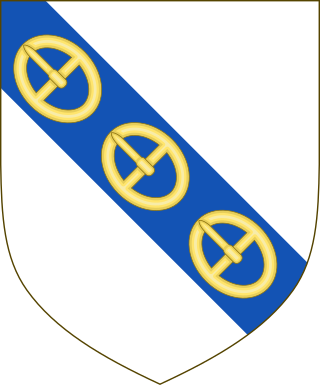
Sir Andrew de Leslie, Lord of Leslie was a 13th-14th century Scottish noble. He was a signatory of the Declaration of Arbroath in 1320. He died c. 1324.

Sir David Lindsay of Crawford was a Scottish noble.
Henry Lindsay, 13th Earl of Crawford also known as Harry Charteris, was a Scottish landowner and courtier.

Patrick Lyon, 1st Earl of Kinghorne was a Scottish landowner.

Sir James (de) Lindsay, 9th Lord of Crawford, Knight Banneret, Lord of Crawford, Kirkmichael, Wigton, Symontoun, and of many other baronies, claiming also to be Lord of Buchan, was a Scottish feudal lord.
Attribution
{{citation}}: CS1 maint: location missing publisher (link)